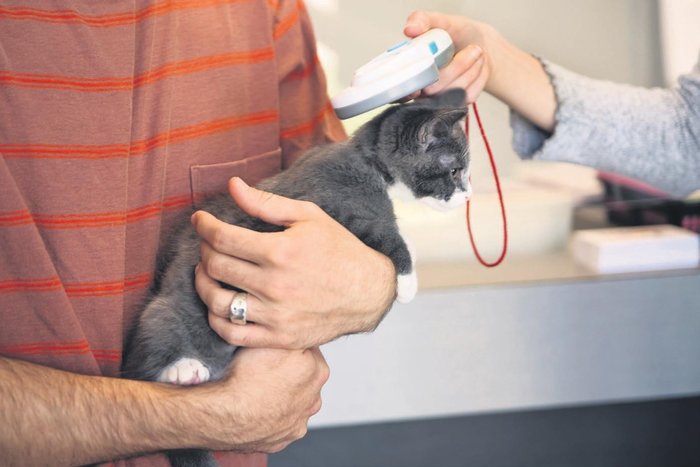Microchipping is a way to give your pet ID without worrying that it could get lost. The microchipping procedure is amazing, making it possible to insert a tiny chip, the size of a rice grain, under your pet’s skin. Once it’s in, it’s very difficult to tell where it is and that makes it nearly impossible to remove. Most people will never know that your pet was microchipped unless they actively check with vets.
What is the Microchipping Procedure?
Most vets will microchip your pet. It’s a minor procedure and doesn’t require anaesthesia.
The microchip itself is registered to a company. You can update the contact information over time if you move or get a new phone number, etc. This chip is very small and fits in a large needle. It may be read with a special scanner that most vets have on hand.
When it’s time to insert the chip, your vet will administer it similar to a vaccine. The location can vary, but most vets will put the chip between your pet’s shoulder blades. The pain is the same as your pet would feel with any needle, but is not dangerous and won’t hurt your pet long term.
The microchip has an ID number on it and while this doesn’t actually contain your information, it gives the vet a chance to check with the company who will provide the information from its database. If you find an animal and suspect it is microchipped, you can take it to the vet and they will scan it to see.
Some people are still reluctant to have a dog tracker chip installed, but it could be the difference between life and death in some cases. There are quite a few benefits to this technology, so let’s take a closer look at them.
Microchipping is Forever
The dog chip is so small and durable that it is nearly impossible to remove unless you’re a vet. This means no one is going to tamper with the chip, either. Once it is in your pet, it is going to stay there unless something odd happens. There are no parts that need to move, so it can’t break down or stop working. It simply has a signal that will be picked up by certain scanners or radios.
Since the chip is so tiny, it can resist a lot of damage, as well. Even if your pet is injured, the chip is placed in such a way that it should be impervious to any type of blow. The vet who attends the animal can then scan to see the ID number, which will lead back to you.
Microchips do not lose their potency, either, so a scan will still read it years from now.
It Helps Lost Pets Return Home
Many pets are recovered due to their microchip. When a lost animal is found, it is often taken to the vet to have it checked over and to scan it. There are multiple stories of pets returning home after months or even years, due to someone checking their microchip. This dog chip is an amazing concept.
The microchip has been responsible for thousands of animals returning to their owner once they were lost. It’s well worth the cost to ensure your pet is protected and can be brought home to you once someone looks at their microchip.
It’s More Effective Than a Collar
A collar, even an electronic one, can be tampered with. The information may be altered and the person who is altering it can rapidly change any information they wish to try and show that the pet is their own. This happens frequently when an animal is stolen and has nothing but a collar.
The microchip, on the other hand, is just a number leading to a private database. Only the owner of the pet can change the information stored on the database and then only after rigorous checks to ensure they are the owner.
A Dog Chip is Proof of Ownership
Let’s face it, some pets look very similar and when a pet has been picked up by someone, they may claim it’s theirs. How can you prove otherwise? In this scenario, there can be two very different outcomes.
First, your pet may not have a microchip and it is your word against the thief’s. They can have a chance at actually taking the animal home and you could lose your pet. It will require photos, paperwork, and a lot of talking to ensure that you are the one who gets to take your pet home again.
In the second scenario, you have microchipped your pet and it is literally as simple as scanning the chip and contacting the database. You will be confirmed as the owner of the pet within minutes. This doesn’t require begging or struggling to find old papers, you can simply prove who you are and take your pet home.
Added Capabilities
Since microchips are RFID chips, they can be used to activate things with scanners. For example, you can get a pet door that will only open for your pets. These doors scan your pet’s chip and then open. If any other animal attempts to do so, they are barred from the door.
Special feed bowls can even allow you to set a diet for your pet or pets. There are bowls that will open only for the programmed pet. This allows you to feed your animals different types of food and the others cannot eat it. If your cat is on a special kidney feed, for example, they can eat the cat food that is designed for their health, but no other pet in the house can do so. Likewise, if you have multiple animals and one tends to steal the others’ food, this will prevent that issue quite nicely.
If you need to monitor your pets’ drinking habits, you can even find bowls that provide fresh, clean water and track when each animal drinks. The product connects to an app and then you add the animal’s microchip. The bowl will scan the pet’s microchip each time it drinks and will track when and how much the pet has had to drink. Even multiple pets can be tracked from your phone, so you always know exactly how much water your animal has had in a day. This is particularly useful if they’re ill and you need to tell the vet how much they’ve had to drink.
As the microchip becomes more common, more products are developed to make life safer and better for your pets and for you, as their owners. With things like the feed bowl or water bowl, you can easily keep animals on track for their health. This also allows you to let the vet know exactly what is happening because you’ll have it all on your phone app.
The Downsides of Microchipping
Unfortunately, while the dog chip will help your pet get home again, it’s not always perfect. Many people believe the chip is a tracker so they can find their dog anywhere. Sadly, that’s not the case. It needs to be actively scanned and does not produce a signal that you can check from anywhere. There is no GPS involved, so just because you have a pet microchipped does not mean you can find them wherever they are.
The other downside is that your pet’s body may reject the chip. This doesn’t happen often, but if it does, you may not be able to microchip your pet. In this case, you may prefer to use a tattoo on the inner lip to help identify your pet. There are other methods, though the microchip is a relatively painless method that will last a lifetime.
When to Microchip Your Pet
Since the chip is so small, it may be inserted early on in life for your puppy or kitten. Talk to your vet about the possibility at the animal’s vaccine appointment, or make a separate appointment for the microchip procedure. Either way, your pet should be protected as early as possible.
Once you have that peace of mind that your pet can be identified in any situation, you will feel the relaxation. It’s much better to know that even if they lose the collar, there’s a simple, foolproof way to identify and protect your pet.
Have you microchipped your pet yet? If not, contact Bay Vets and schedule your appointment. We’re waiting for you.





